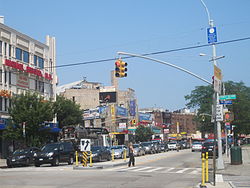Brighton Beach, New York
| Brighton Beach | |
|---|---|
| Neighborhood in Brooklyn | |

Looking east along Brighton Beach Avenue from the corner of Coney Island Avenue
|
|
| Location | |
| Coordinates: 40°34′39″N 73°57′41″W / 40.57750°N 73.96139°WCoordinates: 40°34′39″N 73°57′41″W / 40.57750°N 73.96139°W | |
| Country |
|
| State |
|
| City |
|
| Borough | Brooklyn |
| Population (2010) | |
| • Total | 35,547 |
| Time zone | UTC−05:00 |
| ZIP code | 11235 |
| Telephone area code | 718, 347, 929, and 917 |
Brighton Beach is an oceanside neighborhood in the southern portion of the New York City borough of Brooklyn, along the Coney Island peninsula. According to the 2010 United States Census report, the Brighton Beach and Coney Island area, combined, had more than 110,000 residents. Brighton Beach is bounded by Coney Island proper at Ocean Parkway to the west, Manhattan Beach at Corbin Place to the east, Sheepshead Bay at the Belt Parkway to the north, and the Atlantic Ocean to the south along the beach and boardwalk.
It is known for its high population of Russian-speaking immigrants, and as a summer destination for New York City residents due to its beaches along the Atlantic Ocean and its proximity to the amusement parks in Coney Island.
Brighton Beach is included in an area from Sheepshead Bay to Sea Gate that was purchased from the Indians in 1645 for a gun, a blanket and a kettle.
Brighton Beach was located on sandy terrain, and before development in the 1860s, had mostly farms. The area was part of the "Middle Division" of the town of Gravesend, which was the sole English settlement out of the original six towns in Kings County. By the mid-18th century, thirty-nine lots in the division had been distributed to the descendants of English colonists.
In 1868, William A. Engeman built a resort in the area. The resort was given the name "Brighton Beach" in 1878 by Henry C. Murphy and a group of businessmen, who chose the name as an allusion to the English seaside resort of Brighton. With the help of Gravesend’s surveyor William Stillwell, Engeman acquired all 39 lots for $20,000, a "bargain price." This 460-by-210-foot (140 by 64 m) hotel, with rooms for up to 5,000 people nightly and meals for up to 20,000 people daily, was close to the then-rundown Coney Island area, so it was mostly the upper middle class that went to this hotel. The 400-foot (120 m), double-decker Brighton Beach Pavilion was also built nearby. "Hotel Brighton" (or Brighton Beach Hotel) was situated on the beach at what is now the foot of Coney Island Avenue, and was accessed by the Brooklyn, Flatbush, and Coney Island Railway (the present-day BMT Brighton Line), which opened on July 2, 1878.
...
Wikipedia



